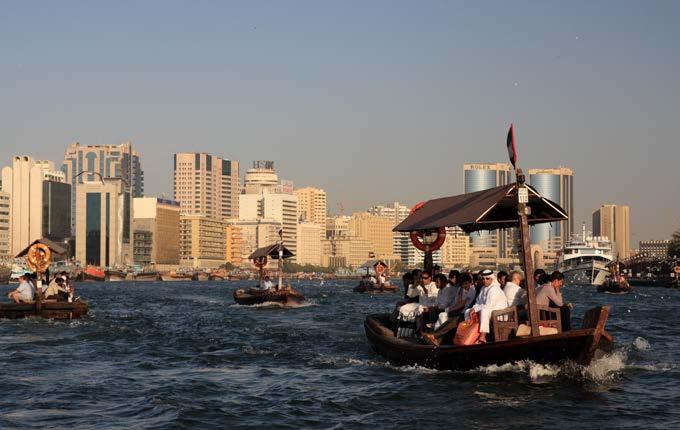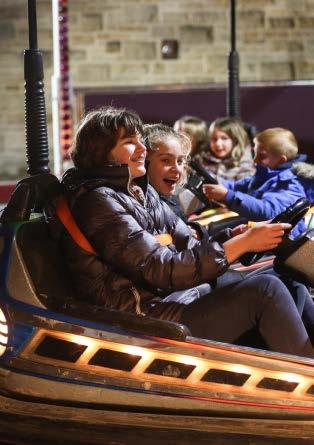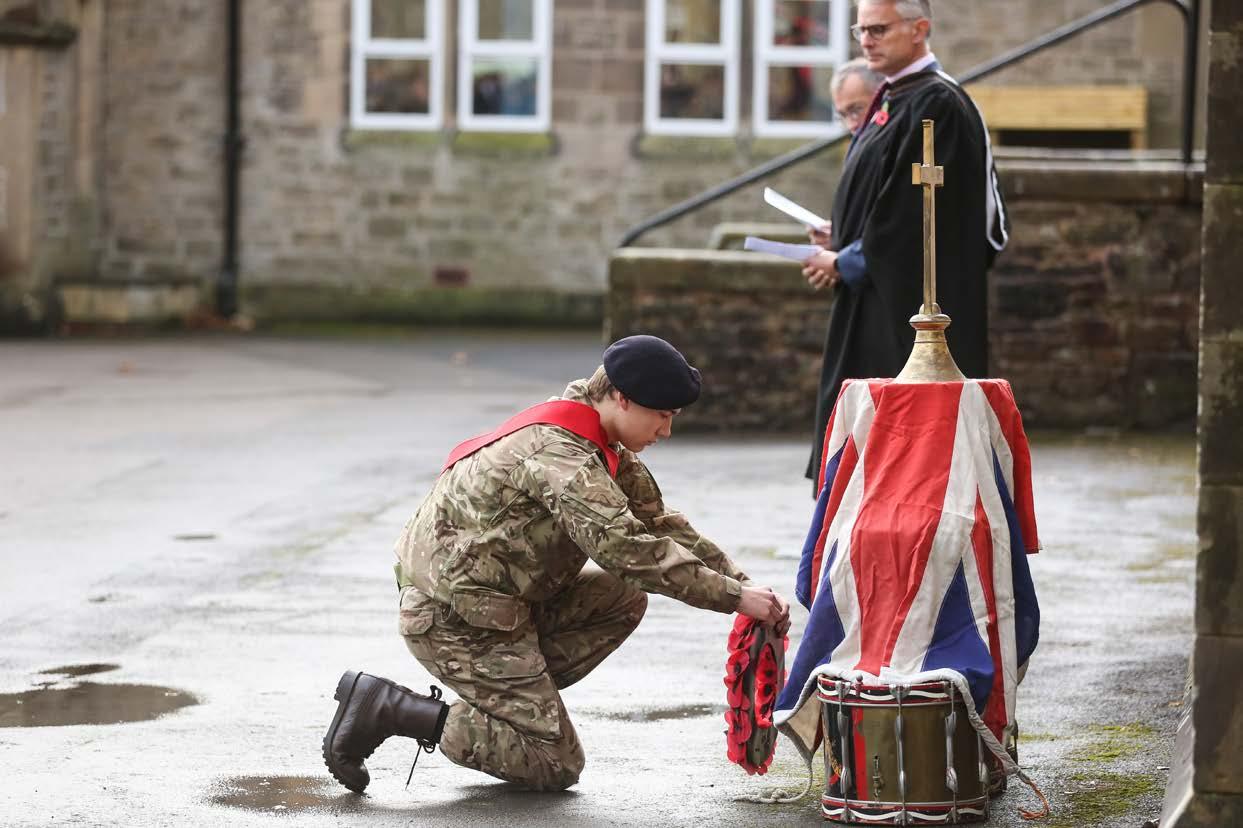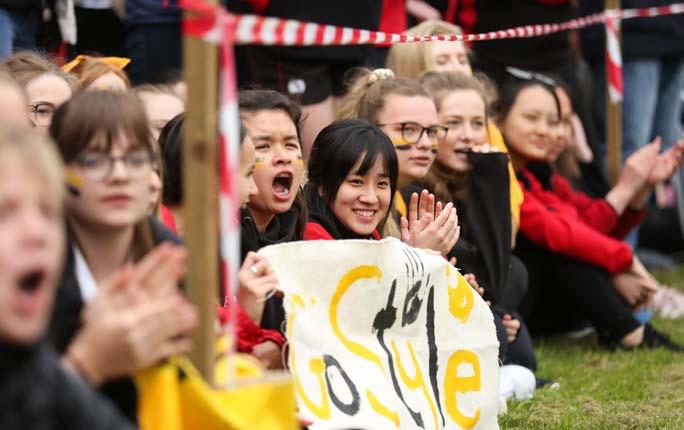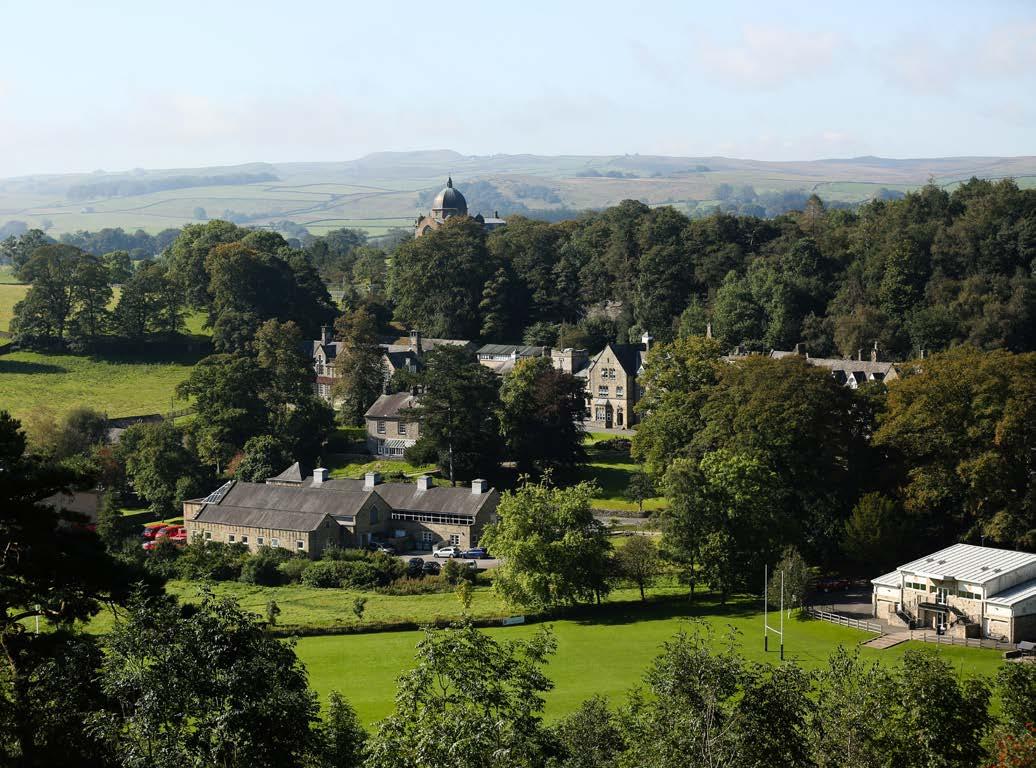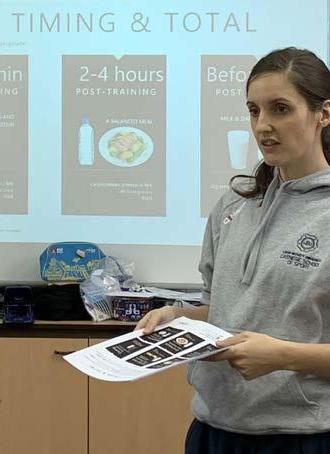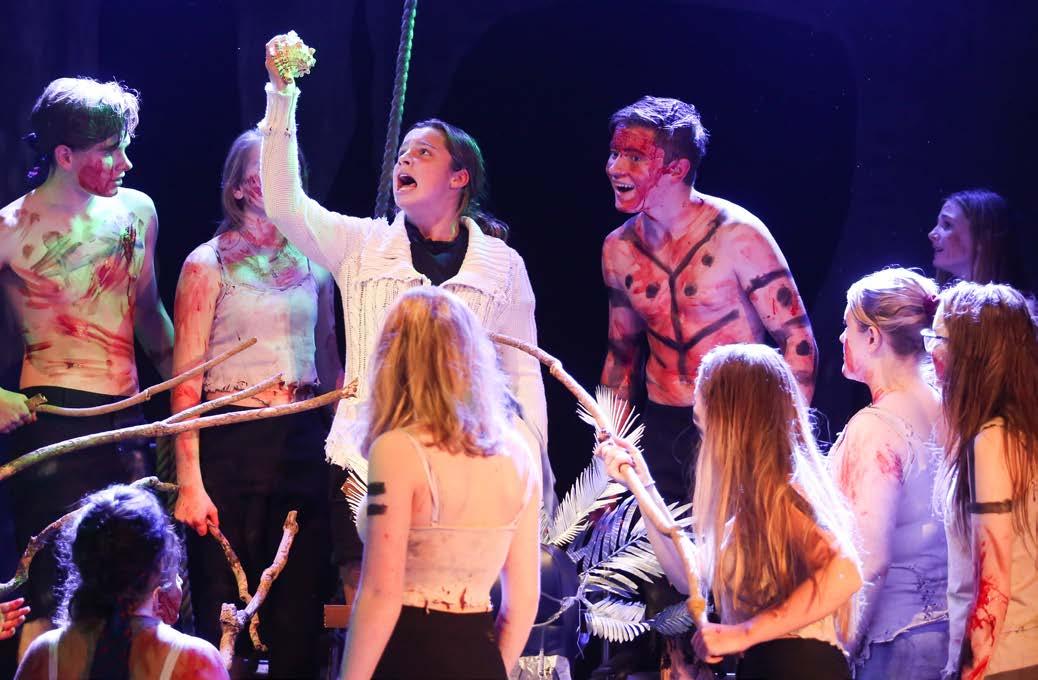
60 minute read
Reflections
REFLECTIONS ON GIGGLESWICK VIRTUAL SCHOOL
This year cannot pass without some reflection on the Covid-19 pandemic and its impact on the students and their learning. So we asked Lily Whewell to interview her family and share their thoughts about this most extraordinary of years.
Advertisement
Out with the old and in with the new. A commonly used phrase by my mum when she is trying to make me clear out my room. However, over 2020 it has developed a new meaning. Out with old routines and in with new ways of living. Before the Coronavirus pandemic, we would never think twice about how lucky we are to be able to meet with friends, go to the pub for a drink after a long, wet walk and attend school in a beautiful Yorkshire Dales setting. If lockdown has brought anything to our lives, it is a time to reflect on not only our own lives, but the world which we live in. It has been a reminder that we are extremely lucky even though we don’t always think about it. Our attitudes have changed over this pivotal period in our lives. Where before hugging a friend seemed a second nature, now it feels awkward and wrong. Popping into the shops is no easy quick task, with socially distanced queues stretching the length of the building and one way shopping systems, it’s no longer a case of “I am just going to nip into the supermarket to get some tin tomatoes and pasta for tea”. Nobody said lockdown was going to be easy. However, it was the closure of schools which affected children all across the nation and the world. The country was forced to shut its doors on normal life, causing Giggleswick School to close on Friday 26th March 2020, and Giggleswick Virtual School to open on Monday 27th April 2020, a new chapter in our school lives, and the most unusual one yet. I never wanted school to close. The idea of not seeing my friends all the time, and staring at a screen all day certainly did not appeal to me. However, my brother Jackson who is in Year 7 and I were much better off than my youngest brother Blake who is still in primary school. Unlike us, he had no virtual lessons, just a work pack of sheets and my Mum as his new teacher. The nature of the worksheets he had been set meant Blake’s disinterest in the work did not improve matters. It was soon clear that if my mum and Blake were to work together more successfully and harmoniously they would have to adapt and change the traditional teaching methods. Their most unusual one yet.” classroom became our environment, not only learning about Maths and English but about nature and gardening which gave Blake a new interest to learn in a different way. The knowledge Blake now has due to the adapted classroom on gardening is incredible, paired with an already apparent enthusiasm for nature the things he has learnt in the past months shows that being sat at a table doing worksheets is not always the best way to learn. Upon reflection of Blake’s home schooling experience, it makes me question how the fundamental elements of conventional ways of teaching have not changed dramatically since the Victorian era, and how should there be new methods in the future? We are constantly being reminded about our changing environment and the impact humanity
educated more on the wonders of nature? Our generation is fed with a constant barrage of negativity, threats that our world is on the brink of ending due to humanity’s destruction and disregard for our home by the media. Should Horticulture and Environmental science be added as a subject in schools, if we educate younger generations to love their planet, would that have an effect on the increase of Climate change? Although in terms of the Climate Change Crisis, is there a time and a place where installing fear in our heads is the only way we will act upon the situation? The Media use a similar method as Hitler did post World War I which caused his rise to power, creating fear in the public’s heads through his speech and propaganda. Only he thought he offered a situation to the ‘problems’ whereas for our situation, there is no seemingly straightforward way. During the pandemic, fear has certainly been a more apparent emotion. If there wasn’t any fear we may not have a will to change our ways to help contain and control the virus. The first week was a struggle for us despite the excellent virtual school system, and our WiFi was in agreement. The days felt long, and the strength and willingness of our WiFi did not improve matters. Somedays our WiFi cut out completely. However, the only thing we could do was to embrace the way we would have to be schooled for the next four months with enthusiasm and perseverance. At the end of the day, we still had the support and expertise of our teachers. At that time, the settling atmosphere was miserable, and when the shortages of certain supply’s like flour and tuna, pasta and of course loo rolls to name a few, it felt like we were living in wartime. Jackson and I adapted our dining room to become our new classroom. I piled my books on the window seat beside me, and Jackson spread his work across our mantelpiece, all of us at home working came with a lot of mess. It felt nice to be working with someone, at school you would be surrounded by people, working and talking so having Jackson working with me gave the situation a greater sense of normality. The large range of different extracurricular activities meant there was something for everyone, and broke up the otherwise screen filled day with a welcome bit of fun. I especially enjoyed the Off by Heart Shakespeare competition, which consisted of learning different techniques such as Iambic Pentameter, having a workshop with Miles Warburton and developing our chosen Shakespearean monologues to eventually film in a short movie clip format and get judged by Miles Warburton and Beth Organ.
The competition was not only fun but helped me to develop my acting skills and learn a lot about the genius language of Shakespeare and how he conveys thoughts and meaning in words. Another exciting competition we were all encouraged to be involved with was Gigg Writes, which ran before lockdown but continued to do so during the virtual school. Every month, a new and different writing challenge would be released, and the entry’s submitted including ones from other members of the Giggleswick community would be sent off and judged by guest authors, including Stacey Halls the author of The Familiars, and Marcus Sedgwick who wrote the poetry book ‘Snow’. It was exciting to have our work read and assessed by real authors, and the range of different themes challenged the whole family to write in ways we wouldn’t usually explore. It was the vast range of activities which we were able to take part in before the pandemic and during, which really set the Giggleswick Virtual School aside from other School’s home learning setups. It was one of the things I enjoyed most about the whole experience. The world slowed down, and so did we. We found ourselves with time to think uninterrupted by the usual modern lifestyles, to live more slowly and appreciate the little things in life. Upon research for this article, I found out that ‘home workouts’ and ‘baking’ had had a huge increase in google searches between January 18th and April 15th in the UK which proves the nations will to live differently. However, it has been proven that working at home may be bad for mental health, but the data from NordVPN which tracks internet usage refers to office workers not school students. The data suggests that a large majority of employees do an extra two hours work a day at home than in the office, meaning many show signs of burn out. The over riding alternative to the suggestion of always working from home in future is to work partly at home, and partly in the office. John Aldridge said, in an article in The Sunday Times that “Working at home was meant to be the future, but creativity and collaboration can only really happen when people are in the
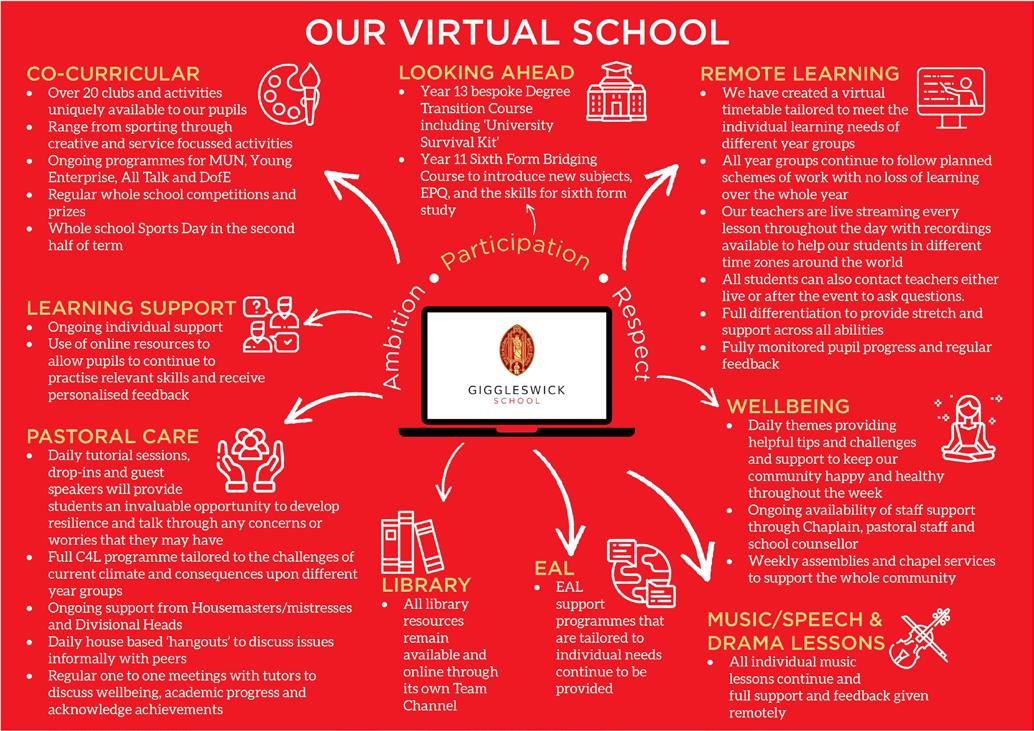
same room,”. It is on Aldridge’s point that I agree on. During Virtual school, we all worked as hard, if not harder than usual to make the most of our education and to continue to succeed despite the circumstances. However, team work, collaboration and creativity seem to not be able to escape from the barriers that learning online put up. If someone was to ask me, based on my experiences, is virtual school the future? I would reply no. Humans are naturally sociable beings, who in the period of lockdown lacked in the usual level of physical contact. At school, we don’t only rely on our independent drive and passion to learn but also one fuelled by others. For many, ambition comes when it is being pushed by others and when working completely independently, ambition might not come as easily. At the end of the day, it is having the drive, passion and ambition to learn and do better that will make us have the most success and make us make the most of our education, supporting us for years to come. Although I felt I was still learning just as much as I would if I was in the classroom, I believe that the social aspect is something you can never achieve virtually, and not having people around me, pushing me to do better meant that I found concentration harder to come by. I learnt a lot through the whole virtual experience. Not only the things we learnt in lessons but the importance of family and friends. With being at home 24/7 and restrictions in place preventing you from living your normal life, I have found when talking with my family about this period that we have all reflected and observed our lives in ways we would never usually. The importance of socialising face to face with other people has never been seen to be so apparent. The need to have people around us in our daily lives is something I never considered before. FaceTime, Zoom, Teams calls have all proven for me that talking to friends virtually will never be as fulfilling as talking in real life. Living in an era where we are very much reliant on technology in our daily lives, having our education completely depend on it for a few months gave us a flavour of the future. Could it be, that in fifty years or maybe even less, the new school experience would be taught virtually instead of in a classroom? As much as I have benefitted from the Giggleswick Virtual School I think it is time to be able to go back to school and enjoy it for what really makes Giggleswick, ‘Gigg’. This period has taught me that we should never take things for granted, and if we all should take one thing from this experience, it’s to always fully embrace in what we are doing, whether we like it or not. Don’t complain when you are freezing and wet, being dragged out in all weathers to play on the hockey or rugby pitch, think of the time when you were sat staring at a screen, longing for the days of matches and sport in all weathers. When the next main school productions come round, despite maybe being a bit shy, audition for a role, or help backstage because you will remember the time you played a part in a great production. Sign up to clubs, participate in lessons and grasp every opportunity which comes
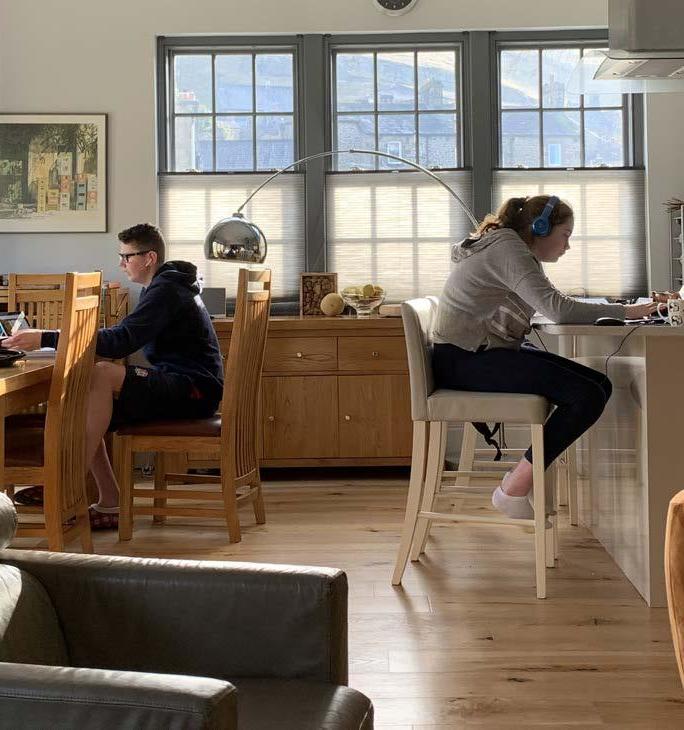
your way in your stride. Giggleswick School provides a vast number of opportunities and experiences which would never be possible in the virtual world, and it is now time we all got back to school, remember the things we learnt in the virtual school and apply it when we all come back in September.
Lily Whewell Yr9 2020
EQUALITY MATTERS: THE NEED FOR INCLUSIVITY IN TWENTYFIRST CENTURY SCHOOLS
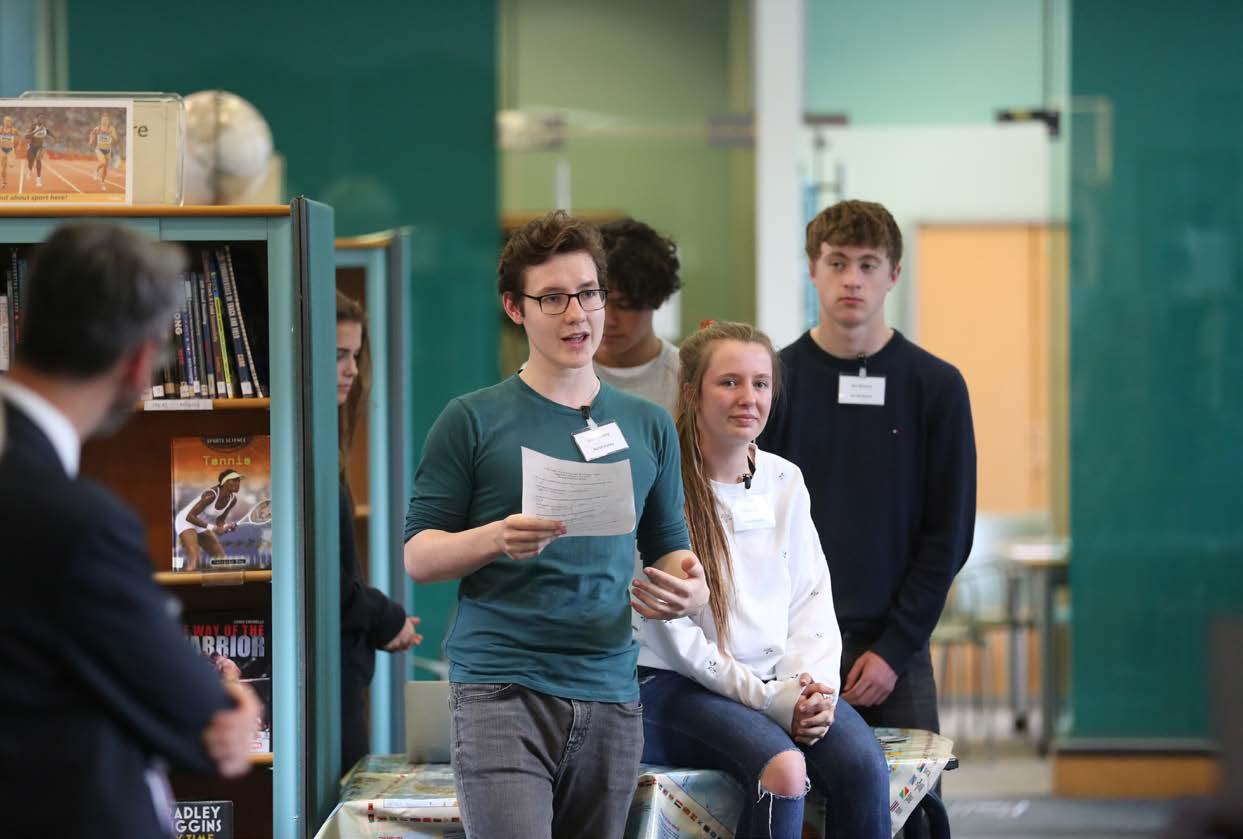
Has there been a more important time in our recent history for the need to understand inclusivity and plurality? Josh KirkhopeArkley has been leading the way on this issue since he arrived at the school in Year 12. Now, as Head Boy he demonstrates outstanding leadership by tackling the issue head on with passion and thoughtfulness.
Equality and inclusivity are often viewed as nothing more than fatuous vernacular used by liberals to demand apologies from history; so, to some, the mere usage of these words may well invoke frustration, criticism, and derision. In our twenty-first century reality, however, it is fundamental that we embrace equality and inclusivity, for they are ingrained in the success of any school, nay any society or nation.
The 1948 Universal Declaration of
Human Rights discusses education in
Article 26, stating that everyone has a right to a meritocratic education, and that education has a cardinal duty to promote tolerance, mutual respect, and inclusivity. If every human being is entitled to an inclusive and tolerant education according to the foundational document on the value of human life in the modern era, then it would be an irresponsible understatement to say that there is simply a need for inclusivity in education, as an underlying pillar of education is inclusivity itself.
Arguably the most essential aspect of education is to prepare students for their everyday life in the future, be it in an academic, professional sense or a social sense. In the Journal of
Higher Education, there is an article in which this is discussed on a more technical level; in this article, preparing students for their future lives in our society is described by Edward
Potthoff as the functional approach to education. He continues to elaborate on how school must contribute to the future functioning of a student in our present-day, twenty-first century society. School environments are, in fact, a microcosm of wider society, and thus have a duty to replicate our modern-day society in order to allow students to learn and grow in an environment similar to the one in which they will have to lead their lives. In the UK, this society is largely an inclusive one – according to the
Berkeley Inclusiveness Index, the social inclusivity of the UK is “high”. Schools, however, can sometimes be areas that do not fully follow this trend of inclusivity – last year, demonstrations were held outside Birmingham schools due to parental anger at a No Outsiders campaign, a pilot scheme aimed at bringing education along the same lines as the 2010 Equality Act. Furthermore, schools with strong religious backgrounds often take issue with education on issues such as LGBT relationships and gender reassignment – either as a result of the conservative views of parents, or as a result of the ethos of the school itself. Certain Jewish Haredi schools have recently publicised that some parents are planning on moving to another country, following the verdict that all schools will have to educate students on the LGBT community. These pertinent examples clearly show that although, legally, schools are required to teach fully on these issues, some continue to refuse, leading to students becoming less engaged in wider British society, which is fundamentally failing its “functional approach”. In the New Internationalist, Andrew Copson discusses how religious schools entrench social divides in students, leading to much less social cohesion in their demographic. Not only are these teachings harmful, as they instil the idea in students that certain groups in society should neither be known about nor included in their sub-society, but it also leads to these subsections within society self-excluding, as they see British societal values as overlyinclusive, and conflicting with their social and religious beliefs. If schools wish to fulfil this “functional approach” to education, then they must use wider society as a model for their school environment. Within UK society, we have targeted diversity groups in different workplaces, LGBT groups at universities and Pride parades all across the country. The UK government has announced a long-awaited ban on gay conversion therapy, thousands in Britain are protesting against systemic racism within state institutions as a part of the BLM movement and we continue to make strides forward within the realm of disabled access to both public and private places. If this is not modelled within schools, then they are abandoning the reason for which they were invented, as they would be consciously and deliberately refusing to prepare students for the future in which they will surely find themselves, and they would be taking full and direct responsibility for the consequential lack of full social integration their students will experience. I judge it appropriate here to quote Rosa Parks, a famous civil rights activist. Rosa Parks famously said that “there is no future without education”, meaning that education brings about the possibility of a positive future. If education is impeded by archaic beliefs and past thoughts, however, education would no longer truly create a future, merely a tragic repeat of the ills of the past. Fascinating studies have been undertaken on the subject of social inclusivity and diversity within schools, and its unique consequences. The Queens University of Charlotte in North Carolina states that studies have shown diversity to have a significant impact on a student’s performance – it specifically mentions that diversity is not only used to make reference to gender or race, but economic backgrounds and teaching styles. A possible reason for this is that social inclusion, equality and diversity all allow students to interact and compete with students who can utilise their individual life circumstances to their academic benefit: fostering interaction between students of different life circumstances allows these experiences and unique perspectives to be both shared and challenged, fostering a productive and creative learning environment. Likewise, if social inclusion and diversity is stifled and not appreciated, students will only learn to see a narrow perspective on life, which is not beneficial in the slightest for their academic progression. If, for instance, a Politics class were only exposed to one opinion throughout their course without ever having to justify it, their opinions would be weak and they would be unwilling to comprehend another’s point of view. Without other opinions and experiences being included in a debate, without this diversity in beliefs, it is significantly harder to justify your own. In an academic setting, the terms equality and inclusivity do not purely refer to their meanings in a societal sense, but also more specifically in a learning environment. A school is
being inclusive when all students are given the opportunity to answer a question, and they are being equal when teachers help all students; these are basic principles of the teaching profession. Although these words typically relate to inclusiveness and tolerance on a societal level, that should not mean that they can only be used in this sense. Indeed, so much of what inclusivity and equality teach us entirely relates to the teaching profession. It is undeniable that are instances during which it is sensible to focus more on certain students than others; to be truly inclusive, one ought to make certain that all students have the help required to understand and benefit from whatever is being taught, and that will always mean that some students receive more immediate support. Equality, however, puts this into perspective; although some students might well receive less direct support, that is not to say that they are simply left alone, with no support. Under this umbrella idea of equality, all students are worthy of support; this may just not be traditional, in-class direct help, but rather a different perspective on the work they are set, or work which specifically targets their strengths and weaknesses. This is why equality and inclusivity should not be treated as controversial topics from which to shy away in fear of causing offence or challenging a status quo: both equality and inclusivity are ingrained within teaching. It is therefore almost nonsensical to argue against schools embracing equality, diversity or inclusivity, as most schools already have, both in their teaching methods and in their curricula. In our school, there are a set of principles that are said to embody the true Giggleswick pupil, the Giggleswick learner profile. One of them is curious – for a learner to be truly mature and successful in their academic career, they must have that curiosity to delve deeper in their subjects. It would be impossible to foster curiosity without including all ideas, from people with different life experiences; without this inclusivity, students would not be curious as their scope would be narrowed, not widened. In the twenty-first century, a skilled learner is someone who has the skill to use existing information within a modern, socially diverse context to make their work more relevant both within their school and within a wider, societal context. Likewise, a student could not be aware without acknowledging both sides to a story; this is a particular point of the BLM protests, to encourage those unaware to learn about the less savoury aspects to typically well-regarded British historical figures. An aware student would build their opinions and conclusions on both sides of a historical figure’s story by including a wide breadth of differing opinions; without inclusivity impede their success.” in curricula or school programmes, it would be impossible for a student to be truly aware. Although resilience does require some sort of difficulty to overcome, having the safety-net of equality and inclusivity would give the student sufficient support to confidently overcome these difficulties. Someone who is passionate about an issue would see where there could be more inclusion, and their passion would lead them to campaigning for change in that area. Without a sense of inclusivity and equality in schools, there would be some passions that schools would not endorse, and others that would be heavily promoted. In a twenty-first century schools, all passions are respected equally. Those who participate in Pride parades are passionate for that cause, and inclusivity has allowed them their passion. A true passion is categorically what leads students to success, and this simply cannot be had without inclusivity or equality. It is absolutely undeniable that creativity relies on all opinions being included in a discussion, as to be creative, it is necessary to have a wealth of information and opinions on which to draw – this allows students to be creative in solving problems. By giving students the confidence to share their own personal experiences, by employing the diversity in a school, students will be able to be more creative. Without equality or inclusivity in a school setting, some pro-active students would be prevented from reaching their full potential, as prejudices and discrimination would impede their success. Finally, to achieve a sense of self-assuredness, a student would need to have been
supported throughout school with an inclusive and equal school community. Simply put, inclusivity and equality have allowed schools to flourish as they have, as has allowed schools to properly foster a productive and supportive environment in which to grow. Without it, the very essence of a good school would be non-existent, as schools would objectively not be achieving any of their objectives. Academically, without equality and inclusion, students would be narrowminded and entirely unaware of their society and the social development of their nation. Pastorally, there would be no real sense of community as students would feel excluded, discriminated against and targeted. Mental health would plummet, and bullying would not be prevented. Surely, schools should be doing everything in their power to prevent this from happening, regardless of short-term comments from critics. If nothing else, for the students. For their present, for their future, and for the future of our society.
SHOSTAKOVICH AND THE POLITICS AND PHILOSOPHY IN THE MUSIC OF THE 20TH CENTURY SOVIET UNION
How would you react if the state tried to control your every creative instinct? Nick Peat explores Shostakovich’s struggle with the tension of politics and the life of a musician which seems to have taken on more significance in the new world of lockdowns and social isolation.
Dmitri Shostakovich was born on the 12th of September 1906 in St Petersburg, just after the 9th of January 1905 slaughter when peaceful demonstrators in the Palace Square of
St Petersburg had been killed by Tsar
Nicholas’ troops. There was already upheaval in every citizen’s heart. His musical abilities were first recognised and encouraged by his mother, who gave him piano lessons from the age of nine. He worked hard at school, and in 1919 he entered the Petrograd
Conservatory, where the director of the conservatory Alexander Glazunov noticed his skill in composition and as a pianist. He wrote his First Symphony for his graduation in 1925, at just 19 years of age, which was critiqued by the Leningrad pianist Druskin; it was “a vocation to realize the concept of tragedy, for this was how he perceived the world.” This shows that even his earliest works were received, not just in terms of their musical merit, but also because of the depth of themes within them; the First’s Finale depicts energy in the face of imminent collapse. His Second Symphony of 1927 and his Third of 1930 he self-proclaimed to be “errors of my youth”.
Over the next years, he faced harsh critiques on his music; his 1934 opera Lady Macbeth of the Mtsenk District was obliterated in an article in Pravda, the official party mouthpiece, entitled “chaos instead of music.” It is crucial to understand why this was, as his next work to be released would be his Fifth Symphony. This Opera premiered in 1934 and was a huge success: it clocked around two hundred performances and was played in many cities outside of Russia including Prague, Copenhagen, London and New York. However, on January 26th, 1936, Stalin saw the opera in Moscow, and it was no coincidence that, two days later, Pravda published the article. It said, “all this is coarse, primitive and vulgar. The music quacks, grunts, and growls, and suffocates itself in order to express the love scenes as naturalistically as possible.”. It went on to explain that its success abroad was down to “the fact that it tickles the perverted taste of the bourgeoise with its fidgety, neurotic music”. This clearly indicates that there was a conflict between the aesthetics and public reception of music and the State’s view of the arts. The source of the opera was a story by Nikolai Leskov which was published in 1865. It tells of Katerina Izmailova, the wife of a mill-owner, who takes a lover from her husband’s workmen. She murders her husband then is deported to Siberia, where she kills her lover’s new mistress, then kills herself. Shostakovich uses this narrative, rebalancing the sympathies making Izmailova’s actions more understandable. She is portrayed as being surrounded by monsters such as her husband, her father-in-law (who bullies her but wants to bed her himself) and her lover who makes empty promises about his fidelity. The opera argues that murder is the only way a woman can revolt in the male-dominated Tsarist time, and Shostakovich dubbed it a “tragedysatire”. Much of its power comes from the double perspective it forces on the listener. The exact reason for its official condemnation is still a subject of debate, but some argue that Stalin saw himself in the hypocritical character of Boris. Many assume that it was the opera’s sex scene, in which Izmailova is seduced by Sergei. There are no stage directions but the music leaves nothing to the imagination. After the article was published, the Opera vanished almost overnight, and

from then onwards it could be argued that Shostakovich faced a life of struggle to maintain his integrity as an artist; he never completed another opera, but without the condemnation of this one, may never have composed his remarkable symphonies which bear witness to one of the most hideous periods in human history, one of which the Fifth is. It was an unhappy period of his life. He was dubbed ‘Enemy of the People’ by a certain newspaper and received anonymous hate mail. Contemplating suicide, he slept in the corridor so that his family would be saved any commotion if he were to be arrested. Amidst such suffering, however, he kept writing music, and much of his music testifies to his suffering. His Fourth Symphony was to be the first piece the public would hear after Lady Macbeth of Mtsenk, and the pressure on Shostakovich to write ‘suitable’ music after his denunciation meant that its performance was withdrawn. The music of the Fourth, first heard in December 1961, is claustrophobic and in some parts terribly violent. In his musical life, Shostakovich showed how music without words could still carry a message for those with ears to hear, a skill which he developed in his 4th symphony. There is absurdity and comedy in one moment, then music with a more disturbing nature in the next. However, this was far from Stalin’s vision for the arts; Stalin had a view that the arts should be, to quote Maxim Gorky, “art that affirms the ultimate rightness of reality”. Any conspicuous hint that this reality had gone wrong could have caused serious trouble. His Fourth Symphony certainly does not show a perfect reality, and it is for this reason that he had to withdraw it. Because it was withdrawn, the first piece the public would hear after his denunciation in Pravda would be his Fifth Symphony. In the Soviet Union of the 1920s, there was a spirit of great creativity, which Bakhurst links with the promise for the creation of a new egalitarian socialist society. However, later in that decade, Stalin had moved to dominate and control Soviet Culture so that he could ensure that art and literature became mouthpieces of the official State ideology, that is, ‘Socialist Realism’. On the 23rd of April 1932, five years before the Fifth Symphony, the Kenyon review reported that proletarian culture had given way to Socialist Realism. Socialist Realism in the arts was said to be “that which gives a faithful and objective mirror to life”. Its primary theme was to be the building of Socialism and a classless society. Although an artist was able to admit any imperfections in the struggle towards a classless society, they were expected to take a positive and optimistic view of a Socialist society. In music of the Soviet Union, there was a decree on this date. Its resolution displaced rebellious proletarian ‘leaders’ and widened the organised circle of artists who came under the banner of ‘Socialist Construction’, who were expected to create art according to the guidelines above. Therefore, the decree ensured party control of new organisations by built in ‘Communist Factions’, and so the arts were now under the control of the Soviet Government. On the eve of the resolution, soviet composers were in a state of tension and frustration. Traditionalist composers felt ignored, the Association for Contemporary Music had been disintegrated and the RAPM (Russian Association of Proletarian Musicians) dominated and controlled the musical scene. On the 23rd of April 1932, the date of the decree, there was a meeting of Composers, musical workers and leaders of the RAPM held at the People’s Commissariat of Education; an eyewitness reported, “Those present take the floor one after another, and attack the RAPM with extraordinary vehemence. It is clear RAPM’s rule, which limited the sphere of creative work, was causing unhealthy conditions for the development of Soviet Music.” The decree of this committee announced the dissolution of all Proletarian associations. It led to the ban of the RAPM and the making of plans for a new creative organisation of unified composers. Before this, traditionalists had felt constricted be extremist factions. It is reported that one composer said after their dissolution; “Now I can write music in three-four time”. This is because the RAPM had insisted that march rhythms were most appropriate for a proletarian society. Shostakovich himself spoke in favour of the decree. The new association of composers and musicologists was named the “Union of Soviet Composers”, and the Composer’s Union Journal, ‘Soviet Music’, was first published in January 1933, and this first issue stated that the development of a Marxist-Leninist musicology was to be the union’s main task. In the Soviet Union on this date, Marxism-Leninism was seen as the only true system of philosophy. V. Afanasyev writes in The Fundamentals of Philosophical Knowledge, the main subject of Marxist philosophy is to solve the attitude of consciousness to being, and that Marxism-Leninism is the only system which answers this problem. Marxism-Leninism was linked to extreme nationalism. It presents the right world outlook and gives a writer the right direction in creative work so that they can accurately describe the greatness of Soviet life, and the achievements of the Soviet man. Therefore, as an artist, Shostakovich would have been undoubtedly affected by Marxism-Leninism as the dominant system of thought when he was writing music; its principles would have surrounded him in everyday life. The world outlook of the MarxistLeninist party was one of Dialectical Materialism. In order to understand how this related to music in the 20th Century Soviet Union, one must first understand its principles. Karl Marx and Friedrich Engels developed this theory, taking the “inner kernel” from Feuerbach’s materialism, and developed it into a scientificphilosophical theory which cast aside any of the idealistic and religiousethical encumbrances which were evident in Feuerbach’s work. The word dialectics itself comes from the Greek Dialego, which meant ‘to debate’, and so Marxist-Leninist Philosophy, therefore, agreed with Ancient philosophers that the disclosure of contradictions in thought and the clash of opinions was the most effective way of arriving at the truth. The Marxist Dialectical
method itself regards all of nature as an interconnected, integral whole in which things are organically connected with, dependent on, and determined by each other, and so no method in nature can be understood if taken by itself. It also purports that nature is not in a state of immobility, but in a state of constant change and movement. Engels writes, “all nature is in a constant flux, in a ceaseless state of movement and change”. It sees development as a process which passes from insignificant, quantitative changes to open, fundamental changes where qualitative changes occur rapidly and abruptly as a result of an accumulation of imperceptible and gradual quantitative changes. As a result, development should always be in an onward and upward movement. Finally, it teaches that internal contradictions are inherent in all things and phenomena of nature. Lenin wrote, “Development is the ‘struggle’ of opposites”, which is seen in the Marxist dialectical method. The Kenyon Review of winter 1942 writes that “the Soviet Union was built and nurtured on Marxism, gathering to itself every element and implication of its outlook.”. The same article also writes that the aesthetics of Marxism cannot be written down in a book, because they arise from the philosophy of materialist dialectics. Along with the task of creating a musicology to suit Marxism-Leninism was another task to make music conform with Socialist Realism. The critic Gorodinsky wrote an article called ‘On the Problem of Socialist Realism in Music’, which stated that it was a problem to translate Socialist Realism, primarily a literary concept, into musical terms. The union, however, came up with the following guideline: “The main attention of the Soviet Composer must be directed towards all that is heroic, bright and beautiful.” “Socialist Realism demands an implacable struggle against folknegating modernistic directions that are typical of the decay of contemporary bourgeois art, against subservience and servility towards modern bourgeois culture.” Such “modernistic directions” were soon called formalism. Formalism and Socialist Realism became the two opposing concepts which have bedevilled Soviet musical aesthetics from the early 1930s until 1988, when Socialist Realism was decreed no longer the official style in the Soviet Union. Shostakovich’s music of the early 1930s cannot be said to belong outright to either formalism or realism, but Gerald Abraham, President of the Royal Musical Association, 1970–74, writes that “so little was Socialist Realism understood at first that Lady Macbeth was accepted as the embodiment of it.” Perhaps this was why it was so widely praised before it’s denunciation. By 1936, formalism was officially defined as “a separation of form from content”. The authoritative Great Soviet Encyclopaedia wrote, “formalism must not be confused with individualised creativity. Genuine innovations in terms of form as well as content, which constitute an indispensable trait of valuable realist art”. In an interview with the New York Times in December 1931, Shostakovich said “There can be no music without ideology. Music is no longer an end in itself, but a vital weapon in the struggle. Because of this, Soviet music will probably develop along different lines from any the world has ever known.” “I consider that every artist who isolates himself from the world is doomed”.
BLACK LIVES MATTER: A LETTER TO THE TELEGRAPH
Black Lives Matters has become one of the defining issues of the early 21st century. Oliver Newbury was so moved by the issue and concerned that the nuance was being lost in the media that he was moved to write a letter to the Daily Telegraph. Passion is not a passive thing and I thought this worth sharing not because it has a particular political agenda but to demonstrate the way Giggleswick learners are engaged with the world well beyond the front gates of the school.
Dear Editor, At this current moment, we are six months into 2020, a year that has, so far, been an unprecedented one.
Australia has been on fire, a war with
Iraq was nearly started, a deadly virus cripples the known world as we know it today and a killing in America which has sparked protests around the world for equal rights and freedom. I'd like to talk about the last part, the modern civil rights movement, the black lives matter movement. This has caused a president to hide in his bunker and chaos to erupt in America and Britain.
I have no issues with the founding principle of this movement. There is nothing wrong with campaigning for something you believe in and if you want something to change you should try and make that change happen. I'd like to pick up about one small part of the movement that is going on inside the wider BLM campaign and this is the vandalism and destruction of statues, especially if they are to do with slavery. We can't impose 21st century laws onto people that were alive in the 17th and 18th century, back then when the slave trade existed the people running it didn't necessarily know that it was wrong to do so. We can't blame people for people in the past for something that they didn't know was wrong.
If you look back in history the majority of great empires have been built on slavery or have used slaves. For example The Great Wall of China was built by slaves, now if we were to pull down/replace/destroy all statues or monuments related to slavery we would have to pull down the Great Wall of China as well as the Pyramids, which were also built by slaves. That’s two of the 7 wonders of the worlds gone because they are associated with slaves. The British Empire, French Empire, British Raj, Dutch East India, Roman Empire, Athens, Sparta the list is endless. If I was to list ever single Empire, republic or dynasty in history I can guarantee that they are related to slavery in one way or another. The problem with this is power. As long as there is power and people, people will abuse the power in order to get what they want. People use people all the time we just don’t call it slavery because we are willing to do it but we are all using people around us and the power we get from that in order to get us to where we want to be. Back then it was called slavery now it’s called employment, school. So back to my main point, I agree with what the BLM movement is trying to achieve, and I wish everyone involved in that movement good luck and I hope that they get what they want from it. I just believe that we cannot enforce our laws onto people that were alive 200 or more years ago. Yours sincerely Master O. Newbury
Oliver Newbury Yr11 2020

THE SEAMSTRESS
In a year when the status of the cultural industries face an existential crisis Giggleswick continues to show its commitment to the arts in all its forms. In this article Lily Verity discusses her passion for art and in particular the work of Charles Baugniet.
Ihave chosen to write about ‘The Seamstress’ by Charles Baugniet (1858). This shows a young seamstress hand sewing in a dark room, making a beautiful wedding dress for a wealthy customer. The theme of everyday work was called painting ‘en situation’ and shows a lot of hidden symbolism typical of Victorian art. I liked this painting because I study textiles and fine art and I am fascinated by the role of designers, and how this painting tells us about their life in Victorian times. The image contains pathos, with the pale seamstress framed by the door as she works. However, the flowers on the table symbolise her hope for the future and the red cloth juxtaposed against the white silk represents her own hope of one day having her own marital love. She holds the needle and thread almost like prayer beads, which is emphasised by the dramatic chiaroscuro tones of the painting. The seamstress epitomises the Victorian work ethic and its religious associations Christian Art
Historian Revd Dr Ayla Lepine, vicar of Hampstead compared this piece to Ford Maddox
Brown’s famous Victorian painting
‘Work’(1865): “work-as practiced in the painting is the Nobel calling of an honest English Everyman ... typifying
English cities but mak(ing) [sic] the rich richer and the poor poorer.”
The accuracy and detail gives grandeur to the humble seamstress, showing the power of the artist to elevate her; likewise the blue ribbon in the basket reminded me of medieval painting where holy Mary is often painted wearing blue garments, like in the nativity scene or Rossetti’s ‘Adoration’ (1858-64). The theme of needle work often occurs in Victorian art and is portrayed as cathartic, this reminded me of the painting ‘The Lady of Shallot’ by William Holman Hunt
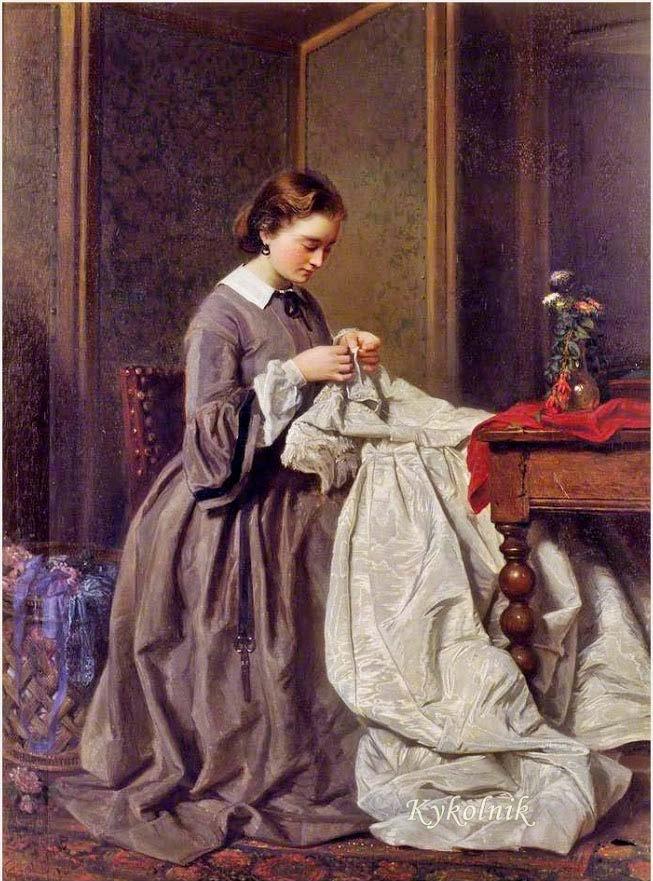
(1886-1905) where the subject sees her life and hopes reflected in a mirror, or Meteyard’s ‘I Am Half Sick Of Shadows (said the lady of Shallot)’ where a romantic medieval setting shows a heroine sewing as she dreams of being rescued. This made me think of the seamstress in Baugniet’s painting wishing for her own escape or rescue into marriage, another respected Victorian institution. When I saw this painting at the V&A last weekend it was displayed amongst other highly detailed Victorian garments making me feel like I was in the picture with the seamstress herself; watching her make the dress with diligent focus. This makes the picture about the past, present and the future simultaneously. The present-day life of the seamstress sees her dreams of the future as she perhaps is daydreaming about stories of long ago, the red of the silk is reflected on her face as she’s thinking about these ideas, and her dreams for the future. The viewer is taken on this journey with her by Baugniet. A modern rendering of this painting could bring a more up to date interpretation. A recent BBC news article explained about how Meritt Singer had invented the first sewing machine which came to the UK not long after this picture was made. Singer “lent weight” to the feminist campaign for better pay and eventually the chance to vote and his machine changed the lives and working conditions of women like ‘the seamstress’ forever. This made me wonder how her life might be about to change with the new sewing machines and ask would her hopes and dreams become better? Perhaps the future seamstresses would not need to rely on marriage forever. The symbolism of the piece tells us about mid Victorian hopes and aspirations but also makes the viewer appreciate the life we live today.
SOCIAL RESPONSIBILITY AT GIGGLESWICK; A FAMILY AFFAIR
Social responsibility seems to run in the Hodge family. So I asked our Bursar, Matthew Hodge and one of our Praepostors, Chloe Hodge, to reflect on the need for Giggleswick to be so much more to the local community and society than just another school.
A STUDENT’S EYE VIEW Over the last four years of studying at Giggleswick, what I appreciated most was the freedom and independence to do what you are passionate about, both inside and outside the classroom, whilst living within a tight-knit support system. It is a privilege to be able to attend an institution like Giggleswick and this is why I believe charity work is vital to educate young people of the wider world and allow them to not take for granted the position they are in. I believe the growth of charity work within Giggleswick school and the act of giving is now a predominant feature within the school culture. This last academic year alone has seen an increase in student-led committees being established such as the Mental Health Committee chaired by Mental Health Praepostor Claudia Humberstone, and the Equality and Inclusivity Committee chaired by Head Boy, Joshua Kirkhope-Arkley. These committees not only have a significant presence and respect around school, they also allow students to express their voice and become more compassionate to those around them. As well as this, they have been proactive giving back to charities which provide support and help to those that need it. This last year alone Giggleswick has raised over £4000 for various charities such as WWF Australia, in aid of the Australian bush fires, and Cancer Research UK. This money was raised through annual events such as the Race For Life which was still able to be run in a slightly different way due to Covid-19 halting many of our events for us this year. Some of these charities have also been chosen by students due to their own backgrounds and wanting to make a direct impact on causes that lie close to their hearts. In December 2019 I was able to organise and lead a Teddy Bear Picnic charity event for the junior school in aid of the Teddy Bear Trust. My aim for this event was not only to raise as much to donate, but to teach the children the value of giving, no matter how big or small. This was such a rewarding experience personally, as the children developed a clear understanding of the purpose of the event whilst being able to enjoy themselves on a level that was suitable for their age. As well as raising over 150 teddy bears to be donated to children in disadvantaged situations, we were able to teach the children of Junior school and Mill House preschool the importance of sharing. Seeing these young children show true gratitude for the things that they own, whilst understanding why it was good to donate some of their toys as well, was so touching to witness. I hope this compassion stays with them as they carry on into the future, as it is a skill which is so vital in day to day life yet often overlooked. I look forward to the charity work that will continue to grow and flourish at Giggleswick school so it can help others as much as it helped me.
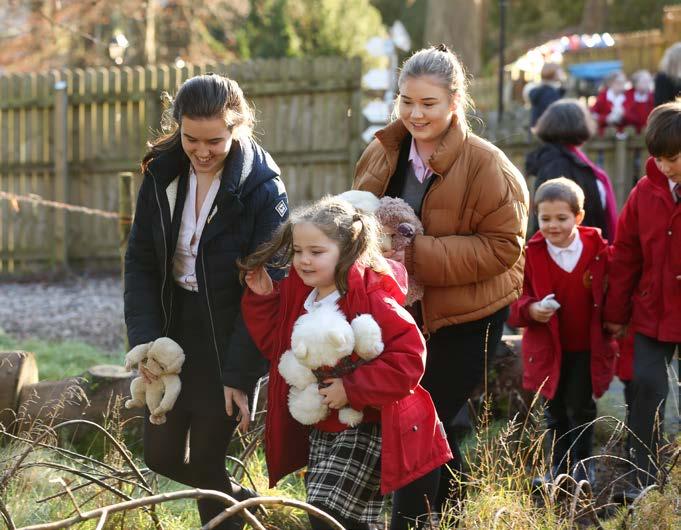
A VIEW FROM THE BURSARY
Giggleswick: A school and a charity
Did you know that Giggleswick School is a registered charity and that a lot of the work of the School is directed at charitable activities? The advancement of education is a charitable purpose and Giggleswick School is classed as an education charity. The charitable objective of Giggleswick School is to “advance education by the provision of a day and boarding school for girls and boys in or near the ancient parish of Giggleswick…and other associated activities for benefit of the community.” Like all charities, we need to demonstrate that the School is here for the public benefit otherwise what is the point of us being a charity? At Giggleswick School we provide public benefit through the activities the School carries out on a day-today basis just by being a school with a broad and varied programme. This includes the advancement of religion through our particular Church of England character, the advancement of amateur sport, the promotion of HM Armed Forces through the CCF and the advancement of environmental protection, conservation and improvement. This might sound a bit theoretical, but there are some very real substantive ways in which Giggleswick supports these aims. This leads me on to the next area under which the School provides a charitable benefit; our role as a community organisation.
Giggleswick – a community organisation
Giggleswick School is one of the largest community organisations in the local area, and we often describe ourselves as a community. We play a central role in this through some very tangible activities, including: • Building links and joint working with local schools and colleges, such as sharing teaching and counselling resources with Settle College and proactively working with local primary schools and providing resources and running events; • Working in partnership with local sports clubs, schools and other groups to share Giggleswick facilities, such as the all-weather pitch, and through provision of staff to undertake coaching activities outside the school; Access for the community to the Richard Whiteley Theatre and Giggleswick School Chapel, which provide worship and a programme of theatre, film and performance; Through a range of community partnerships, initiatives and activities such as working with the local Rotary Club to provide a venue for the safari supper event, hosting the village summer fete every August and supporting the Duke of Edinburgh’s Gold Award team at other schools.
Giggleswick – widening access
The third area in which the School fulfils its charitable remit is in making a Giggleswick education available to those who may not be able to afford it. Our policy is to offer a certain number of places every year at a reduced cost through means-tested bursaries. We can only afford to fund a certain number of bursaries every year but we do encourage donations to support the funding of bursaries. In any one year up to 47 pupils at Giggleswick receive some form of bursary support. We also help families secure funding from other charitable foundations, including the Royal National Children's Foundation, Buttle Trust, the BMTA Trust Ltd, the Northern Counties Children’s Benevolent Society, The Reedham Trust, Children of Heroes, and the Collinge Trust. The total financial impact of this help on the School is close to £400,000 each year. We also support families serving with HM Armed Forces by providing funding to support their fees. This charitable activity costs the School over £100,000 each year. Alongside this the School sends up to £700,000 on scholarships each year, meaning we spend £1.2m annually on subsidising fees.
Giggleswick – impact on the economy
Giggleswick School is one of the largest employers in the North Craven area and makes a significant contribution to the local economy by employing local people and bringing new people into the area. We also make a contribution through the good and services we buy to run the school, through providing educational and cultural activities and through providing housing. It is possible to measure the impact of all this using a model developed by Oxford Economics and RSAcademics. The model looks at the School’s contribution to Gross Domestic Product (GDP), the number of jobs that exist as a result of Giggleswick School, and what the School contributes to the government through tax. This model shows that Giggleswick School’s total contribution in 2018 to UK GDP is £13.7m. The School’s total contribution to the GDP of Craven District is £7.5m. The School supports 0.53% of all GDP in Craven District. The total number of UK jobs supported by Giggleswick School activities is 401. This includes 118 UK jobs supported by the spending of our staff and of our UK-based suppliers’ staff, and 44 jobs supported in our UK-based supply chain. The total number of jobs in Craven District supported by School activities is 279, of which 239 are directly employed by the School. Giggleswick School therefore supports 0.75% of all jobs in Craven. To add to this, the School is by far the largest employer in Settle and surrounding area. The total amount of UK tax supported by Giggleswick School activity is £4.7m. Of this total, £2.0m relates to the School’s payments of employer NICs, business rates and taxes on business supplies purchased, plus payments by the School’s staff of income tax and NICs. The total savings generated for the UK taxpayer, as a result of attendance at Giggleswick School by pupils who would otherwise take up a free UK state school place, is £2.1m. So it can be seen that Giggleswick is more than a school – it’s an important local charity and key player in the community, providing employment and widening access to the benefits of a Giggleswick education.
AN EXPLORATION OF THE RELEVANCE OF CCF IN 2020
Giggleswick. Friday. 13:45pm. It’s raining. The Head of Giggleswick School’s Combined Cadet Force orders ‘CCF ON PARADE’. Have you ever wondered why, on a Friday afternoon, what an outsider might think about what the CCF is, or indeed why we do it?
In 1859, the Secretary of State for War, Jonathan Peel, wrote to public schools and universities inviting them to form Cadet Units of the Volunteer Corps. The pupils wore the uniforms of their parent Rifle
Volunteer Battalions and undertook army activities, shortly evolving to
Officer Training. During World War I and World War II, many young men who served in these units went on to serve for their country on the front line.
Giggleswick cadets were no exception, and sadly some did not return. After
World War II, the Cadet Units became the Combined Cadet Force 1948 to include Cadet Sections from the Royal
Navy, Royal Marines, Army and Royal
Air Force, and the focus began to move away from solely a recruitment pathway, and girls were allowed to join.
Today, we are fortunate not to be at World War. The Cavaliers and the
Roundheads are no longer arguing.
Yorkshire and Lancashire are on good terms – most of the time. And yet there are more than 42,000 CCF cadets in the United Kingdom.
So why do we need a CCF today?
It is understandable that on face value, a Combined Cadet Force can appear to be merely about learning to shoot at a target and march in the rain, all whilst dressed like miniature soldiers. But it is about so much more than that. CCF inspires young people, encouraging them to grow their abilities and challenge their limits.
We are so fortunate at Giggleswick with the vast range of extra-curricular activities on offer and, as such, pupils have the rare privilege to learn just as much outside the classroom as they do inside. And this couldn’t be more true of CCF. It will never be everybody’s cup of tea, and its compulsory nature is often questioned by Year 10 cadets when they stand on parade for the first time; however, whether they choose to stay until the end of their compulsory year, stay for their DofE volunteering, or stay until they leave Giggleswick, each cadet gains valuable skills, experiences and memories which they will never lose. I know I certainly have. Initially, as a wide-eyed Year 10 cadet knowing little of what to expect, your first week on the parade ground will see your curiosity inspired. Ahead of you is the chance to experience shooting, marching and mountaineering, while picking up many transferable skills from your time in the ranks. It is throughout this time that your awareness of those around you improves; you learn that the challenges and tasks you face are far easier when you work together, becoming mindful of not only looking after yourself, but others too. Passion is instilled in every member of the section as you work towards a common goal, whether it be to win the annual parade competition, or to finish the section battle drill quickly so everyone can escape the wind and rain! And numerous opportunities such as these provide the chance to practise, improve and master leadership skills, whether it be as In Command, Second in Command, Platoon Commander or Platoon Sergeant in battle drills or on overnight exercises from your first week, or Head of Army, Marines, RAF or even CCF in your final year. CCF presents its own set of unique challenges such as mastering marching manoeuvres and passing a Weapons Handling Test, but also has those that you can set for yourself like completing your Silver or Gold Duke of Edinburgh’s Award or achieving your Marksman’s badge for target shooting, or winning ‘Best Cadet on Parade’ at the annual Summer Camp. These in turn build up your resilience week by week, developing your ability to find creative solutions to the problems that may arise and increasing your self-reliance without even realising it. Completing these challenges leaves you with confidence in yourself knowing you did, and a unique foundation of skills to build on throughout your time in the CCF, your time at Giggleswick, and when you leave the school environment. I will certainly be taking much away from my time in the CCF and as the Head of Army: the ability to problem solve under pressure, an aptitude for prioritising and enhanced leadership skills that I will carry with me for the rest of my life.
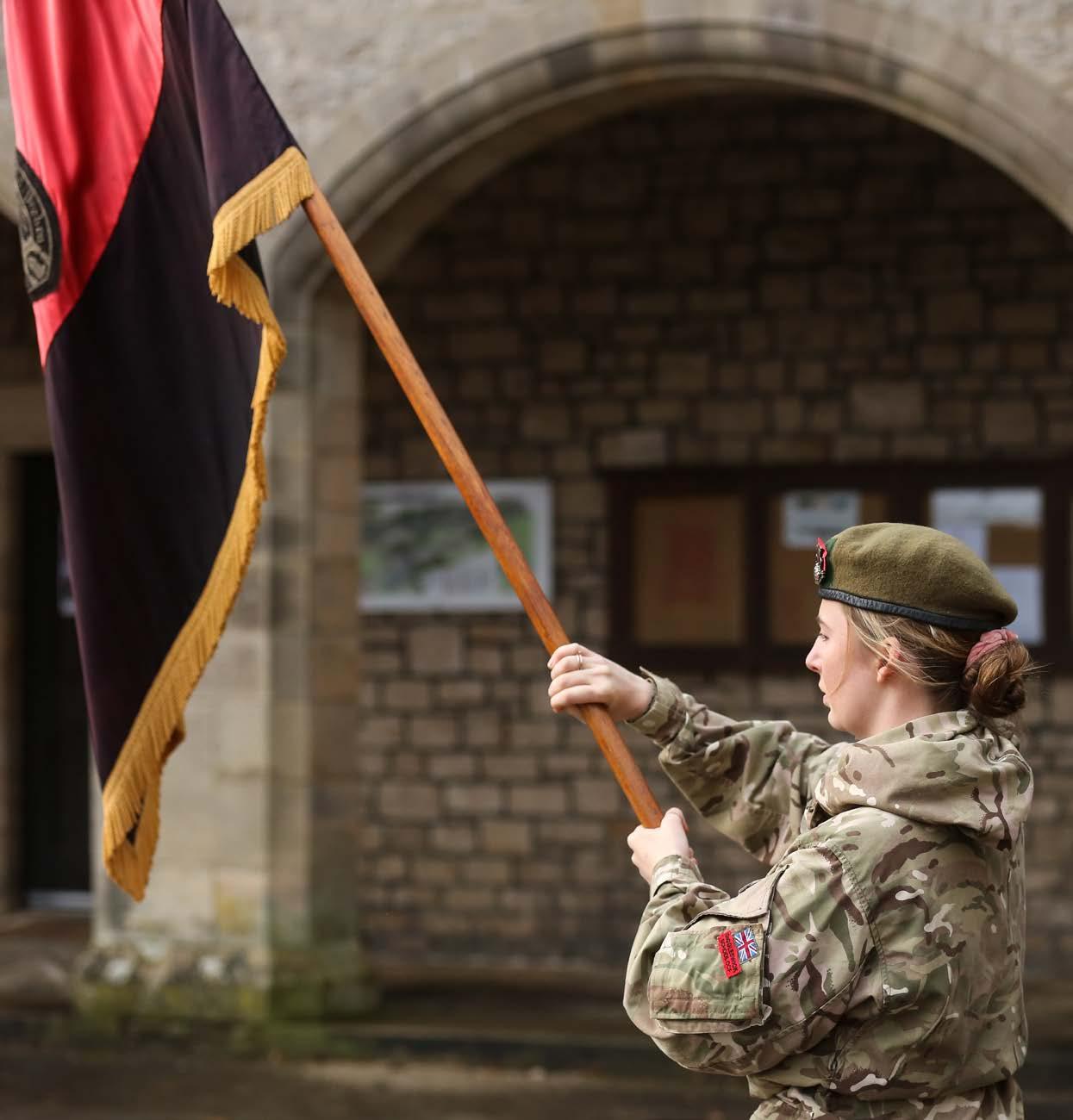
WHAT ARE THE KEY FACTORS THAT ENABLED DUBAI’S RAPID ECONOMIC GROWTH, LEADING TO THE CREATION OF A GLOBAL METROPOLIS
We are very proud at Giggleswick of our diverse student body. Here, Aaron Harrison explores his passion for architecture and the built environment by discussing the growth of his home, Dubai.
Having lived abroad all my life I have always been very passionate about the study of built environment and architecture. What struck me about
Dubai was how the economy linked had also been a powerful instrument, allowing the promotion of growth and development. After looking at different articles from various academics and comparing them with my trip to Al
Shindagha Museum I found that the comparison of global economies against further influences of trading and types of industry within Dubai create valid arguments as to how geographical advantages helped propel Dubai forward. It is now a heavily relied upon trading industry within the gulf region. As I discovered from an interview with Mr. Al Muhairi, a local orientalist of historiography working in the Al Shindagha museum, archaeological excavations in Jumeira reveal that there was a high degree of civilisation in the Dubai area around 3,000 BC where an Italian explorer in 1580 described Dubai as a prosperous community with its people largely engaged in pearl diving. Dubai first became an independent political entity in 1833, when men of the Bu Flasa tribe settled in the area. However, Dubai’s economy prospered after 1894 when Sheikh Maktoum Bin Hasher Al Maktoum gave tax exemption to foreign traders; this aspect of a tax free lifestyle is carried out to this day and has ultimately proved a necessity for the introduction of expatriates into the economy. Before the 1950s the city’s main exports were pearls, shells and dried fish, and imports including dates from Basra; rice, sugar, pepper
and cereals from India; wood and cane from East Africa. The city had relative wealth due to its early pearl industry, and it soon began to accumulate population from Persia, the Indian subcontinent, and other Arab countries. The city only had a small amount of oil resources compared to other cities in the area, such as Abu Dhabi, and as a result its ruler Sheikh Maktoum decided to use the money to attract tourism and financial services from around the world which could prove to be a more sustainable, ensuring sustainable development. Over the next few decades millions of expatriates came, attracted to the lack of taxes. Today only 5% of Dubai’s population is comprised of locals out of a population with over 9.4 million people. According to Mr. Al Muhairi the introduction of expatriates into Dubai was the key factor that enabled its rapid development; the encouragement of foreign doctors from the United States of America as well as businessmen from the United Kingdom were essential for the start of international trade alliances promoting the United Arab Emirates’ global presence, ultimately commencing the beginning of foreign investment into the local economy. Obtaining money from these investors allowed development to prosper around the creek and now what is considered ‘old Dubai’, before later spreading out further along the south west coast where newly implemented ports and free-zones were constructed in aid of larger cargo ships arriving from across the globe. I evaluated the validity of two articles against my findings from Mr. Al Muhairi. The two articles, ‘City of Gold,
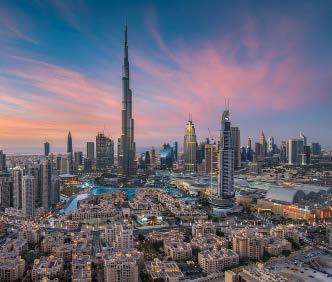
City of Slaves’ by Nicholas Cooper, and ‘Dubai: Foreclosure of a Dream’ by Christopher Davidson, described the extent to which the work of immigrant populations was relied upon in creating Dubai’s success. According to the Government of Dubai Statistics Center, a staggering 96% of its employed population is made up of immigrant workers; Dubai is unquestionably dependent on this population. Both pieces of literature seem to demonstrate this factor as being an acceleration in the development from the start as business’ migrate and open up overseas headquarters and chains, adding to the GDP per capita of Dubai and ultimately strengthening the overall economy. Consequently, like Davidson, in ‘Dubai: Foreclosure of a Dream’, he describes the uncontrollable economic growth of the city; Nicholas Cooper also follows a similar point by criticizing Dubai’s immense dependency upon its predominantly immigrant working population, and as economic recessions begin to affect job security and businesses in Dubai, the unreliability of this immigrant workforce poses and creates massive threats to the continuance of Dubai’s ever-growing city. dson also criticizes the sustainability of Dubai’s success, describing economic recessions occurred, where in 2008 many cranes stood motionless, traffic clearing up, redundancies and therefore expiring of VISA cards then pushed out lots of it’s prioritized migrant workforce. As a result, as supply continued to increase with the rapid developments in infrastructure, the levels of demand dropped significantly, causing a near crash in the market as housing prices plummeted as there was an excess in supply. However, Cooper then develops his argument into ethical concerns over treatments of many laborers as he describes that laborers are forced to work long hours in the dangerous desert heat on construction projects and are not given sufficient breaks as required by law. Similarly, Cooper infers that many health and safety violations are rampant on construction projects and implies that the government does not enforce these regulations thoroughly, however this perhaps is another reason contributing to Dubai’s rapid growth; cheap labour. Over the past two decades Dubai has grown astonishingly fast, with credit, cheap labor and tax-free incentives promoting foreign investment and immigration. Similarly, 96% of its employed population is made up of immigrant workers; Dubai is unquestionably dependent on this population who are responsible for much of the cities fast paced development. On the other hand, external influences are also pose a key contribution as the success of neighboring Emirates played a big role in enabling Dubai’s success to continue; the Abu Dhabi government and the UAE central bank gave $20 billion in loans to Dubai in late 2009 in a multi-billion-dollar debt restructuring effort, and although Dubai is on track repaying it, the city is still billions of dollars in debt despite being renowned for its large amounts of wealth. As a result, this mostly unknown aspect of Dubai is rarely heard about amongst the public due to the municipality and rulers of Dubai playing a key role in what information gets out to the public through strict rules/guidelines; this bias makes any opinionated articles from news sources such as Gulf News less reliable as they are almost guaranteed to have been modified, challenging me to evaluate and assess which sources to trust as well as which sources I can compare and triangulate with to make my research more reliable. ‘City of Gold, City of Slaves’ is written by a professional within the University of New Mexico where the source has been peer reviewed and cross checked with other academics; this suggests that the information given is accurate and suitable to use when arguing which of the factors had the most significant role in defining Dubai’s success. However, Nicholas Cooper’s intention tends to rely on giving a very opinionated view upon Dubai as Cooper describes the negative impacts without much counter argument. Consequently, when reviewing the information through further reading I have the understanding that it is very much one sided and the relevant information must be reviewed in context with other sources showing positive connotations to Dubai’s economic status and development in order to build an accurate and representation. Various rulers followed an open policy where late Sheikh Rashid Bin Saeed Al-Maktoum pioneered Dubai’s modern development as a renowned trade centre. Dubai faces the future with confidence on the strength of a modern infrastructure, combined with excellent trade and an international financial reputation. Moreover, the boom in economy at the beginning of the 20th century due to the growth of the pearl trade induced pearl traders to finance new schools. New schools had an impact on changing the nature of education where literature, grammar, reading, writing, and arithmetic was integrated amongst the schooling systems alongside religious studies. In the past, fishing and pearl diving were the mainstays of Dubai’s early economy, however the economic crisis and collapse of the pearl industry dramatically affected the entire Gulf region in the early 20th century as newer artificially acclaimed pearls dominated the market from the far East. Despite this short downfall in the economy, new trade partners, as well as the re-exportation and storage of goods, allowed Dubai to increase its economic power in the world again.
This was the age of the development of Dubai’s economy – its emergence as a business-friendly city. Much of Dubai’s wealth is accredited as a result from the influences of the natural creek, as Gulf New Media and Mr. Al Muhairi suggests, the creek was the nucleus of Dubai’s initial growth. Dubai lies on a natural creek, Khor Dubai, which runs inland for about 10 km and was the nucleus for the city to develop. The Creek epitomises Dubai’s unique beauty where people settled at both sides at Dubai as well as Diera. Prosperity as a port dates around 1902, when Dubai became the main anchorage in the area for dhows coming from neighbouring ports and as far away as India and East Africa. North winds caused silting in the centre of the Creek, which made the passage of large vessels difficult. The late Sheikh Rashid Bin Saeed Al-Maktoum started a scheme in the 1950’s to deepen the channel and reinforce the banks. This gave a much-needed boost to Dubai’s economic development. The two sides of the city are connected by AlMaktoum Bridge built in 1962, and Al Garhoud Bridge in 1976. Today, Dubai Creek is the main artery for trade in the Emirate where there are hundreds of dhows of different sizes, loading and unloading a variety of goods which induced Dubai Municipality to construct the new Dhow Wharfage introduced in 1993. This was to cater for the increasing number of ships docking on the Creek. The merchants, businessmen, and people of Dubai Creek were instrumental members of the community. They contributed enormously to quality of life and heavily influenced the area’s development. Some merchants owned ships, while others were suppliers, but they all relied on the creek for prosperity. Ultimately, there are various factors that all played an important role in the exponential growth of the city, with more upcoming strategies as well. In less than five decades, the UAE has achieved one of the highest standards of living in the world. Although the UAE’s prosperity rests in part on its vast hydrocarbon reserves, the government has made substantial efforts to diversify and encourage a more mixed and sustainable economy. Moreover, a significant strand of the UAE’s new future will be developing alternative and sustainable sources of energy, both for the benefit of the country and as a strategic asset in which the country can become a global leader. The UAE has successfully started to diversify its economy into manufacturing and service sectors to create both a sustainable economy and employment for its growing population as the main industries have shown significant changes from oil and gas (28.9%) to the newer branch of tourism (5.2%) which is currently the highest growing sector. In relation to tourism, Dubai’s strategic location, where 2/3 of the world’s population lives within an 8hr flight from the UAE and 1/3 lives within a 4hr flight, has shown to be a prominent factor for providing the growth of its newly formed sector. However, the heart of Dubai’s success is very much orientated around the presence of the Dubai creek as it has proven to provide for Dubai’s economy even since ancient times. Along with the creek comes the aspect of trade and international connections through the Gulf thanks to Dubai’s fortunate geographical positioning, of which has accelerated the development of infrastructure due to neighbouring migrants from India and Pakistan moving to work in the UAE for very low labour costs. Similarly, the low labour costs combined with tax exemptions have created the ideal situation for business provenances; allowing a much greater working population full of international migrants helping to excel the economic growth further alongside its finite oil and gas funds.
Aaron Harrison OG 2020
